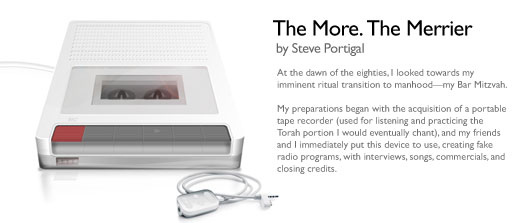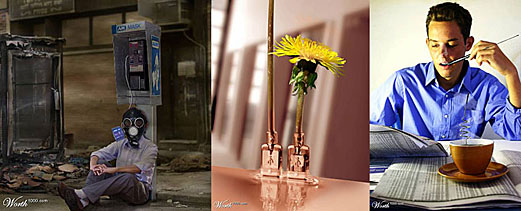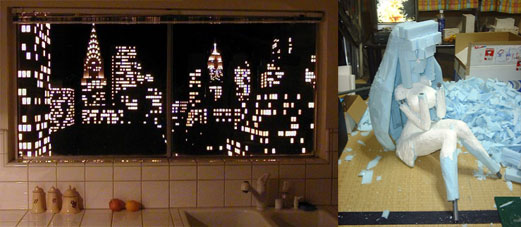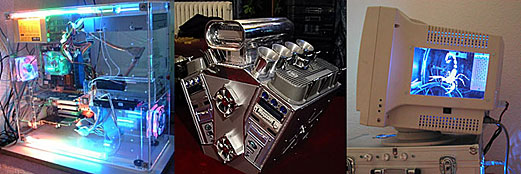|

Illustration for Core77 by Hans Inge Hagen
The post-modern media parodies of National Lampoon and Saturday Night Live were well-established at that point, but not to a 13-year-old. To us, presented with a new enabling technology, it seemed perfectly natural to play along
with the big boys, pretending to be on the radio.
These new technologies continue to appear. Within recent memory, some products that put previously unachievable professional-grade abilities in the hands of ordinary people include video cameras, desktop publishing, teeth whitening,
home theater, hairstyling products, and home dry-cleaning. Further, consider some of the brands that offer "professional" as part of their promise: Hummer, Jeep, Viking, Thermador, SubZero, Bosch, Nikon, and Smart and
Final.

In our culture there is a growing interest in trying to be like the professionals. As consumers, we're interested in how business is done. The popular press reports the amount of money that a new movie makes in its opening weekend.
Advertisements (most recently Dell) profile the product designers, user researchers, usability testers, and others who are behind the scenes for the products we buy. Many of the ubiquitous reality-TV shows are simply pulling back
the veil on a previously hidden process (MTV's Cribs documents the homes of the famous, Take This Job… tracks the work activities of people with unique occupations, Airline shows the minutiae of getting passengers boarded for
an on-time departure, and Family Plots tells all about a family-owned funeral home). The boundaries between consumer and producer continue to blur, a change that was massively accelerated by the Internet. For more about this, check
out The Cluetrain Manifesto. Customers (fans, really) of companies form communities to debate how those companies and their products should evolve. For example, Google's social networking site
Orkut includes two communities with over 1000 subscribers: "What Should Google Do?" and "What Should Orkut Do?"
Roll Your Own
But beyond simply acting upon that sense of ownership by talking about the companies, many people are taking advantage of new enabling technologies (i.e., Photoshop) to go one step further—to create new "products."
And, with a distribution channel like the Internet, they can also share their creation with an enormous audience, just like the professionals.
Fan-created fiction (or "Fanfic") is artifact of fandom in general, but the quantity and breadth of Internet sources further demonstrates the extent of consumers acting, literally, like producers. The "Lois
and Clark" Fanfic archive has over 2300 stories and is updated regularly. There are other fanfic sites devoted to NYPD Blue, Law and Order SVU, Felicity, anime characters such as Sailor Moon, and video games including Max
Payne and Zork. As well as—you guessed it—many, many Star Trek sites.
Similarly, DVD Tracks is a site that was set up to host alternative commentary tracks for DVDs, recorded as MP3 files by ordinary viewers.

Illustrations: cl0ckw0rk, ufosgalore, tranquil222
For products, specifically, one of the most popular formats for consumer-developed concepts is the parody. SomethingAwful.com runs a regular forum where participants create realistic, disturbing, obscene, bombastic and hilarious
product concepts, ads, book covers, movie posters, and more. Check out fictitious recalled food products like Nestle Boogers, or fake
religious toys such as Biblical MadLibs and Erotic Dreidels.
Some people might look at those pages and groan, grimace and think "Hardy-har, I've seen stuff just like that on comedy TV shows." And that's exactly the point—now ordinary folks can create parodies of real products
and services as well as commercial media. Ironically (or frustratingly, if you can't handle too much recursion) this trend was beautifully pegged in a Saturday Night Live parody ad for computer they called McIntosh Jr. Using the
tagline "The Power to Crush the Other Kids" one young boy earns the envy of his classmates by printing out a fake brochure for the "pubic library." See the ad here;
it's still great.
Beyond straight-up parodies, we can find people crafting conceptual visions of the future. Look at this worth100.com
page to see wireless coffee delivery and payphones converted to clean air dispensers, among other imaginings.

Photos courtesy of ipodlounge
But what probably hits closest to home for many of us are the proposed design evolutions of real products, created by regular people. Maybe you always wanted a beautiful iPod
watch, and at ipodlounge.com, you can see 150 other iPod concepts—new form factors, new finishes, skins, features, and more.
These people obviously have real passion and enthusiasm for the iPod. We also find a similar energy with an eagerly anticipated product update, such as the Nintendo DS. When the public has no idea what their future object of desire
will look like, fake images begin circulating to feed that hunger. Gizmodo.com, an excellent site for information about the latest technology products, has been soliciting concepts
for the Nintendo DS as part of their campaign to obtain an actual pre-release image of the product. They are even offering a bounty for whoever can provide
this image.

Models: Ryan Hoagland, Kanna Higashi & Katsuya Matsumura
A further variation is the how-to information created by enthusiasts who not only share the result of their project, but also publish detailed instructions for others who may want to duplicate their example. They are publishing
their own designs, and the means for others to complete that same design. Want to build a lit cityscape for your kitchen window? See how Ryan Hoagland did it at hoagy.org/cityscape.
Mike Harrison tells you how to build a Nixie Tube clock at electricstuff.co.uk. Physically modifying a PC (or "casemodding") has produced an entire subculture
of DIY hardware designers who are no doubt influencing manufacturers like Alienware. See the process of building a casemod that looks like an anime girl, or visit moddin.net
to see ultra-custom designs like a toaster, an Underwood typewriter, a V8 engine and others that evoke futuristic technogeek wet dreams. The turn-your-Mac-Classic-into-an-aquarium meme became so widespread that there is an entire
collection of Mac-based aquariums.

Mods: Clinton, hotrodled, soerennielsen
There's a party in my mind and everyone's invited
Product designers may have a negative knee-jerk reaction to all this. Who do these people think they are? Up to this point, the limited availability of glorious tools (and training needed to use them) placed this type of speculative
conceptual activity out of the reach of the masses. Now the technology, if not the ability, is within reach of millions. But for designers this really is a "the-more-the-merrier" situation. These new enabling technologies
(i.e., Photoshop and its brethren) further the discourse about what is possible, and what is desired—and that discourse is an essential ingredient in the work we do for non-fake clients.
For example, consider how user research methods such as participatory design (also known as PD) explicitly harness this desire. PD asks regular people to help design future products. The designers work directly with users to identify
needs, rapidly prototype solutions, and iterate those solutions on-the-fly. Although some may fear that bringing non-designers into the actual pencil-and-paper moments of design may reduce the designer to a mere sketchmonkey, PD
is not consumer-led design. The designer takes the lead, informed by what the users know best—the problems they have today with existing products (of a lack of product). People will offer alternatives to ideas suggested by
designers, but the biggest value for the designer is in understanding the needs behind that input (i.e., it's not clear that people are ready for an emergency fresh air dispenser as suggested above, but we can see the connection
between that concept and existing products such as the USB-based personal ionizers that are sold online).

When someone says, "I want a handle," that shouldn't be taken literally. The need being expressed is, "I need an easy way to carry this device into another room." The designer is not simply implementing a wish
list, but is actively translating and transforming. That's what they do best anyway: act as a magic engine that takes in needs and spits out wants...in a way that solves the need. No one really needs an iPod watch, but they may
want one. And, indeed, some people want one badly enough to create a picture of what it would be like.
Participatory design is a significant shift in how we approach user research—instead of focusing on the problem we are now working with users to develop the solutions. Of course, in the process of creating products, the needs,
wants, and solutions are often just proxies for each other as we struggle to articulate half-baked ideas. But half-baked ideas are artifacts of the creative process. It's exciting that these regular people are already creating partially
cooked concepts on their own, without a client, without a PD session, without a designer, or a facilitator. For the designer who seeks to center their solutions in the world of the user, rest assured that the users are already headed
out to meet you halfway.
If we ever wanted proof that such a thing is possible, that everyone really is a designer, we need look no further than these impassioned expressions of desire to be involved with products we love.
Comment on this article here in the Article Forum
Steve Portigal is a Bay Area design researcher who studies customer behavior and customer culture to develop new product strategies for his clients. He writes FreshMeat, a semi-regular newsletter about design, culture, business,
and technology at http://www.portigal.com/FreshMeat.htm. Check out Steve's website at http://www.portigal.com.
|



![]()






